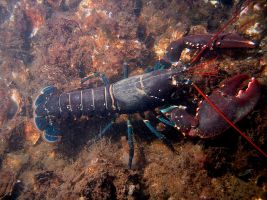The English nouns lobster and locust are doublets. Doublets (or etymological twins) are words in one given language that go back to the same etymological source but differ in form and meaning—cf. also turban – tulip, clock – cloak, pastiche – pastis and fawn – fetus.
The word lobster is from Old English forms such as loppestre, alterations of Latin locusta, which originally denoted the locust, later also the ‘locust of the sea’, that is, the lobster or some similar crustacean.
In Latin, the word is attested in the latter sense in the Natural History (Naturalis Historia – 77), a vast encyclopedia of the natural and human worlds by the Roman statesman and scholar Pliny the Elder (23-79); chapter 50 of Book 9 thus begins:
locustae crusta fragili muniuntur in eo genere quod caret sanguine. latent mensibus quinis.
translation by John Bostock and Henry T. Riley (1855):
The cray-fish, which belongs to that class of animals which is destitute of blood, is protected by a brittle crust. This creature keeps itself concealed for five months.
The Old English word is attested around 1000 in a text in the form of dialogues, aimed at teaching Latin, both as vocabulary and as grammar, through use of the Old English words and constructions. In one of those dialogues, the master asks the fisherman what he catches in the sea and the student, taking the fisherman’s part, replies:
Alleces et isicios, delfinos et sturias, ostreas and cancros, musculas, torniculi, neptigalli, platesia, et platissa, et polipodes, et similia.
Old English gloss:
hærincgas and leaxas mereswyn and stirian ostran and crabban muslan pinewinclan sæcoccas fagc and floc and lopystran and fela swylces.
translation:
herrings and salmon, dolphins and sturgeons, oysters and crabs, mussels, periwinkles, shellfish, plaice and flounder, and lobsters and many things like that.
The Latin locusta in the sense of locust appears for instance in the Vulgate, in which the gospel of Matthew, 3:4, is:
ipse autem Ioannes habebat vestimentum de pilis camelorum, et zonam pelliceam circa lumbos suos: esca autem eius erat locustæ, et mel silvestre.
New International Version:
John’s clothes were made of camel’s hair, and he had a leather belt round his waist. His food was locusts and wild honey.
In English, the word is first recorded in a homily of the early 12th century, De Sancto Iohanne Baptista; it says, about St John the Baptist:
wilde hunie and languste his mete [= food]. and water was his drinke.
In the Early Version (around 1382) of the Wycliffe Bible, the gospel of Matthew, 3:4, is:
Forsothe that ilk Joon hadde cloth of the heeris of cameylis, and a girdil of skyn aboute his leendis; sothely his mete weren locustis, and hony of the wode.
In the Hebrew Scriptures there are nine different names for the insect or for particular species or varieties. In English Bible translations, they are sometimes translated as locust, sometimes as beetle, grasshopper, caterpillar, palmerworm, etc. The precise application of the several names is unknown.


